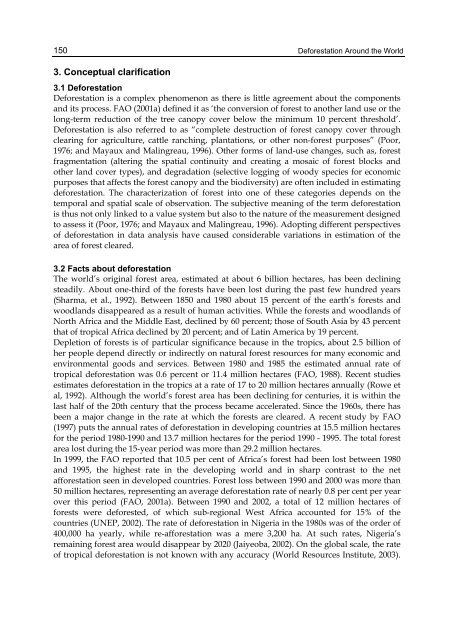DEFORESTATION AROUND THE WORLD - India Environment Portal
DEFORESTATION AROUND THE WORLD - India Environment Portal
DEFORESTATION AROUND THE WORLD - India Environment Portal
Create successful ePaper yourself
Turn your PDF publications into a flip-book with our unique Google optimized e-Paper software.
150<br />
3. Conceptual clarification<br />
Deforestation Around the World<br />
3.1 Deforestation<br />
Deforestation is a complex phenomenon as there is little agreement about the components<br />
and its process. FAO (2001a) defined it as ‘the conversion of forest to another land use or the<br />
long-term reduction of the tree canopy cover below the minimum 10 percent threshold’.<br />
Deforestation is also referred to as “complete destruction of forest canopy cover through<br />
clearing for agriculture, cattle ranching, plantations, or other non-forest purposes” (Poor,<br />
1976; and Mayaux and Malingreau, 1996). Other forms of land-use changes, such as, forest<br />
fragmentation (altering the spatial continuity and creating a mosaic of forest blocks and<br />
other land cover types), and degradation (selective logging of woody species for economic<br />
purposes that affects the forest canopy and the biodiversity) are often included in estimating<br />
deforestation. The characterization of forest into one of these categories depends on the<br />
temporal and spatial scale of observation. The subjective meaning of the term deforestation<br />
is thus not only linked to a value system but also to the nature of the measurement designed<br />
to assess it (Poor, 1976; and Mayaux and Malingreau, 1996). Adopting different perspectives<br />
of deforestation in data analysis have caused considerable variations in estimation of the<br />
area of forest cleared.<br />
3.2 Facts about deforestation<br />
The world’s original forest area, estimated at about 6 billion hectares, has been declining<br />
steadily. About one-third of the forests have been lost during the past few hundred years<br />
(Sharma, et al., 1992). Between 1850 and 1980 about 15 percent of the earth’s forests and<br />
woodlands disappeared as a result of human activities. While the forests and woodlands of<br />
North Africa and the Middle East, declined by 60 percent; those of South Asia by 43 percent<br />
that of tropical Africa declined by 20 percent; and of Latin America by 19 percent.<br />
Depletion of forests is of particular significance because in the tropics, about 2.5 billion of<br />
her people depend directly or indirectly on natural forest resources for many economic and<br />
environmental goods and services. Between 1980 and 1985 the estimated annual rate of<br />
tropical deforestation was 0.6 percent or 11.4 million hectares (FAO, 1988). Recent studies<br />
estimates deforestation in the tropics at a rate of 17 to 20 million hectares annually (Rowe et<br />
al, 1992). Although the world’s forest area has been declining for centuries, it is within the<br />
last half of the 20th century that the process became accelerated. Since the 1960s, there has<br />
been a major change in the rate at which the forests are cleared. A recent study by FAO<br />
(1997) puts the annual rates of deforestation in developing countries at 15.5 million hectares<br />
for the period 1980-1990 and 13.7 million hectares for the period 1990 - 1995. The total forest<br />
area lost during the 15-year period was more than 29.2 million hectares.<br />
In 1999, the FAO reported that 10.5 per cent of Africa’s forest had been lost between 1980<br />
and 1995, the highest rate in the developing world and in sharp contrast to the net<br />
afforestation seen in developed countries. Forest loss between 1990 and 2000 was more than<br />
50 million hectares, representing an average deforestation rate of nearly 0.8 per cent per year<br />
over this period (FAO, 2001a). Between 1990 and 2002, a total of 12 million hectares of<br />
forests were deforested, of which sub-regional West Africa accounted for 15% of the<br />
countries (UNEP, 2002). The rate of deforestation in Nigeria in the 1980s was of the order of<br />
400,000 ha yearly, while re-afforestation was a mere 3,200 ha. At such rates, Nigeria’s<br />
remaining forest area would disappear by 2020 (Jaiyeoba, 2002). On the global scale, the rate<br />
of tropical deforestation is not known with any accuracy (World Resources Institute, 2003).

















